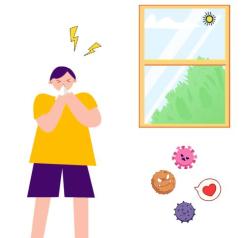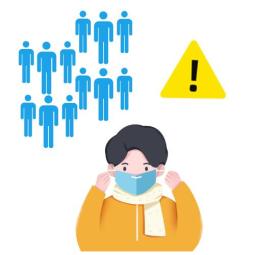How to prevent influenza in winter? How to take medicine after infection?
The cold wave strikes, and every time this season, colds seem to become "frequent visitors." In the office, subway and bus … I hear sneezing and coughing from time to time.
Many people have complained that they feel weak all day after catching a cold, and their whole body aches, and sometimes they have fever, which is even heavier than usual colds. If you have the above symptoms, you are likely to have influenza, also known as flu.
Winter is the season of influenza, and the intensity of influenza is increasing in many places at present. How can we prevent it? How to distinguish influenza from common cold?
Today, we invited Li Yanhong, director of Peking University Shenzhen Hospital, to lead us to understand the flu and take preventive measures during the winter solstice.


National monitoring data show that influenza is the main respiratory infectious disease in China, and the number of reported cases in China is increasing gradually, among which influenza A virus and influenza B virus are the main sources of infection.
The flu is coming, which makes people wonder why it is more vulnerable to the flu in winter.
First of all, when the temperature drops in winter, the influenza virus is more likely to survive and spread in a cold and dry environment.
The transmission route of influenza is mainly respiratory droplets, and it can also be transmitted directly or indirectly through oral cavity and nasal mucosa. In winter, people prefer to move indoors, with many people in contact and a relatively sealed environment, which undoubtedly creates good conditions for the spread of the virus.
Secondly, the immune system may be weakened in a cold environment, and in winter, people do relatively little exercise and outdoor activities, and the sunshine time is short, which leads to the decline of vitamin D level, relatively weak immunity, and are more susceptible to influenza virus infection.

Furthermore, if you still have bad habits such as unbalanced diet and lack of adequate sleep, which affect the health of the immune system, the flu will easily find you.
In a word, the increase of influenza patients in winter is the result of many factors, from environmental conditions to people’s behavior habits, which will affect the spread and incidence of influenza.


Influenza and common cold are two different respiratory diseases. Although they are both caused by viruses, there are some differences.
● Virus type: Influenza is caused by influenza virus, while common cold is caused by many different viruses, such as rhinovirus and coronavirus.
● Severity: Compared with a cold, the course of influenza is generally longer, taking 5-10 days, and the symptoms are usually more serious, mainly including high fever, severe headache, body aches, cough and sore throat. The common cold can be cured in 5~7 days, and its symptoms are relatively mild, usually manifested as respiratory symptoms such as stuffy nose, runny nose, cough and sore throat.
● Onset speed: The onset speed of influenza is relatively fast, and the illness is rapidly aggravated within one or two days. The onset of the common cold is slow, and the symptoms gradually appear.
Comparison of onset speed

● Scope of infection: Influenza usually causes a large-scale epidemic, while the common cold is commonly spread among individuals.
● Risk of complications: Influenza may cause serious complications, such as pneumonia, myocarditis and craniocerebral encephalitis. The common cold generally has fewer complications.
Generally speaking, the flu is relatively serious and spreads quickly, while the common cold is lighter and has a smaller spread range. In terms of treatment and prevention, influenza needs more attention, while the common cold can generally be relieved by rest and appropriate drugs.

At present, influenza has entered a period of high incidence, and the following susceptible groups need special attention.
For example, pregnant women, young children, the elderly, patients with chronic diseases such as heart disease, lung disease and diabetes have relatively weak immunity and are more susceptible to influenza virus.

Although influenza is mostly a self-limited disease, symptomatic treatment is generally adopted to alleviate symptoms, but a few patients can develop pneumonia and even rapidly develop into severe diseases.
Therefore, for people susceptible to influenza, it is necessary to do personal protection.


The key to prevent influenza is to strengthen personal protection;
◆ Pay attention to hygiene: wash your hands with soap and water frequently, or use alcohol-based hand sanitizer, especially after touching public places, coughing and sneezing.
◆ Healthy lifestyle: keep enough sleep, eat a balanced diet, exercise moderately, improve your immunity, and keep windows open and ventilated every day at home.
◆ Wear a mask to avoid contact with viruses: Be sure to wear a mask when going out, try to avoid close contact with people who have been infected with the flu, avoid going to crowded places, and reduce the chance of infection.

◆ Vaccination against influenza: Influenza vaccine is one of the most effective ways to prevent influenza. Regular vaccination against influenza can improve immunity and reduce the risk of influenza infection. In particular, people with poor resistance can be vaccinated against influenza in advance.

If you have flu symptoms, it is recommended to rest at home and keep enough rest. Minimize contact with others, drink plenty of water, and properly ingest foods rich in vitamin C, such as citrus fruits and green leafy vegetables, which will help relieve symptoms. For ordinary patients, it is mainly symptomatic treatment.
○ fever < 38.5℃: physical cooling.

○ High fever (≥38.5℃): antipyretic drugs such as ibuprofen and acetaminophen can be taken;
○ Cough and expectoration: ambroxol hydrochloride, acetylcysteine, Su Huang to relieve cough;
○ Diarrhea: probiotics, montmorillonite powder, etc.
At the same time, it is also necessary to use targeted anti-influenza drugs, such as oseltamivir and mabaloxavir. However, it should be noted that oseltamivir and mabaloxavir are mainly used for the treatment of influenza A and B, but not for the common cold and bacterial infection. And when used for treatment, the sooner the flu symptoms appear, the better, and it needs to be taken within 48 hours after the symptoms appear, which can shorten the duration of symptoms.
Tips: oseltamivir and mabaloxavir are prescription drugs, so it is best to take them under the guidance of a doctor.

Expert style
Li Yanhong:
Chief physician, Department of Respiratory Medicine, Shenzhen Hospital, Peking University
Good at direction:
He has been engaged in clinical, teaching and scientific research work in respiratory medicine for more than 30 years, and went to the hospital of Japan Independent Medical University for further study in 2014. He undertook theoretical teaching and clinical teaching for 8-year graduate students in Peking University, presided over the completion of one Shenzhen-level project, and published more than 20 papers in SCI journals and core journals.
Social service:
He is currently the vice chairman of the Shenzhen Medical Association’s respiratory disease society of integrated traditional Chinese and western medicine.
Vice Chairman of Allergy Committee of Shenzhen Medical Doctor Association
Vice President of Shenzhen Respiratory Diseases Branch of Chinese Medical Doctor Association
Vice Chairman of Allergy Prevention Committee of Shenzhen Preventive Medicine Association
Member of Guangdong Allergy Branch
Member of Respiratory Diseases Branch of China Geriatrics Society.
Standing Committee member of Shenzhen Medical Association Respiratory Disease Branch
Member of Sleep and Respiratory Branch of China Geriatrics Association.
▍ Image source: giphy.com; Network. If there is any infringement, please contact to delete it.
Read the original text